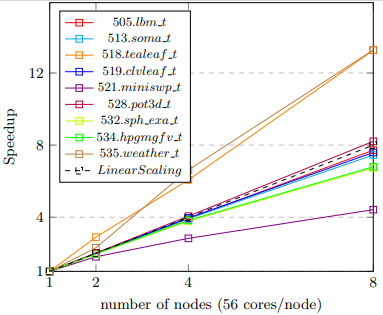SPEChpc Releases New v1.1 Benchmark
By Mathew Colgrove, SPEC High Performance Group Release Manager
With the release of the SPEChpc™ 2021 v1.0 benchmark
last October, we have seen a great response from the HPC community. More than 100
institutions have received no-cost, non-commercial licenses, including large research
facilities, universities, and even a few high schools. Beyond measuring performance
of HPC systems, users have used SPEChpc benchmarks for educational purposes and
installation testing, as well as to find node configuration issues, to name a few.
Paraphrasing Nicole
Hemsoth's The Next Platform article, SPEChpc is the benchmark real-world
HPC deserves.
SPEChpc benchmarks are ported to use multiple parallel models, MPI, OpenMP (using
either host or target offload), and OpenACC, allowing for performance comparisons
across a wide range of systems, including both homogeneous and heterogenous architectures.
While porting applications to vendor-specific or language-specific parallel models may
provide a better understanding of a system’s peak performance, the use of directive-based
approaches, which are supported by multiple vendors, allows for better comparison of
general performance.
While v1.0 has been well received, a few users reported issues, so we are proud to
announce the release of the SPEChpc v1.1 benchmark. While primarily a bug fix release,
with the MPI and OpenMP host threaded results being comparable to v1.0, we did find a
few performance problems with the OpenACC and OpenMP Target Offload versions. Hence,
take care when comparing v1.0 results using these models. The full list of changes can
be found at: https://www.spec.org/hpc2021/Docs/changes-in-v1.1.html.
To upgrade to the SPEChpc v1.1 benchmark, current users can contact the SPEC Office at [email protected] or use runhpc's update feature. New
users, qualified non-commercial academic and research institutions can apply for a no-cost license. Commercial users may purchase the SPEChpc benchmark.
The SPEC/HPG Release Manager (me) did make a slight error in v1.0, where I missed changing
the update version. Hence, to use the runhpc update feature, please do the following.
- Install the SPEChpc v1.0 benchmark or cd to an existing installation, source
either 'shrc' or 'cshrc', depending on the shell you are using.
- Edit the file "$SPEC/bin/common/vars_common.pl", changing the "current_version"
at line 23 from "0.1.9" to "1.0.3".
- Run the command "runhpc –update".
Note that the system does need a direct internet connection to perform the update.
You can confirm the update by viewing the 'version.txt' file, which should say
'1.1.7'.
SPEChpc Weak Scaling
The current SPEChpc benchmark workloads are strong scaled, i.e., time to solution
of a fixed-size workload. As more system resources are added (in our case more MPI
ranks), with perfect scaling, the time solution would decrease proportional to added
resources. However, elements such as fixed overhead and MPI communication will
eventually reduce scaling efficiency until the point when adding more resources
no longer improves performance.


To help with scaling, the SPEChpc benchmark includes four separate workloads, one
for each Suite: Tiny, Small, Medium, and Large, each progressively larger than
the next. As one workload reaches the top of the scaling curve, the next larger
workload can be used. However, even the Large workload will eventually reach the
top of curve and the SPEChpc benchmark can’t be effectively used past this point.
The exact point at which this occurs varies widely by the system in use, with denser
compute nodes, such as those with attached acceleration devices, reaching the top
with far fewer ranks.
While strong scaling is an important aspect of system scaling, SPEC/HPG is currently
developing a complimentary weak scaling benchmark. Users will be asked to provide
the workload size to use, tailoring the size to their system. However, given the
workload size will be variable, time to solution can no longer be used as the metric.
Instead, weak scaling will use a throughput metric, a figure of merit (FOM), measuring
the amount of work performed over a fixed amount time. The exact FOM used will be
determined by the individual benchmark, but an example would be the number of ray
traces computed per second.
Not all applications are capable of weak scaling, including about half of the current
SPEChpc benchmarks. Hence, SPEC/HPG has introduced the SPEChpc
Weak Scaling Search Program asking you to submit your applications as candidate
benchmarks for this new suite.
The search program includes an award of up to $5000 as an appreciation of your contribution.
Applications can come from any domain but should be HPC focused. Full applications are
encouraged, but often mini apps work better. Candidates are preferred to not have
library dependencies, but accommodations can be made for portable libraries, such
as HDF5 or NetCDF.
While the candidates will eventually be ported by SPEC/HPG to use multiple parallel
models, OpenMP, OpenMP with Target Offload, and OpenACC, the submitted candidate need
only to use MPI and at least one of the models. If only using OpenMP, there should
be nothing in the code that would prevent it from being offloaded to accelerator devices.
We encourage you to review the search program, and even if you are not quite sure that
your application fits, submit your code as a candidate!
Internal Timer Table
When starting to look at weak scaling, we determined that only the core computation time
should be used to compute the FOM. If we included the overhead time, users would need
to increase the number of time steps or workload size higher than necessary in order
to amortize the overhead. As such, we added internal timers, using MPI_Wtime, to break
out the MPI start-up overhead, the application initialization time, and the core compute
time (core compute includes MPI communication time).
We thought it useful enough that we decided to include this in the SPEChpc v1.1 benchmark,
with the internal times shown in the log files. Optionally, you can have these times
added to your reports by setting "showtimer=1" in your config file or setting "runhpc –showtimer=1"
when running the benchmark. Don’t worry if you forgot to do either. You can go back and
edit the resulting "raw" file (.rsf), setting the “showtimer” field to 1 and reformatting
your results with the "rawformat" utility.
Full details of this new feature can be found at: https://www.spec.org/hpc2021/Docs/changes-in-v1.1.html#timer.
This feature is intended to be used for informational purposes only. It cannot be used in
place of the reported SPEChpc benchmark metrics, though it may be useful for scaling
studies where the overhead cost can be extracted out. It is also useful for understanding
the MPI start-up costs on systems. For example, one user was comparing her system performance
to that of a sister organization that had a near identical system but performed much better
than hers. She was able to determine that a poor configuration in the nodes start-up was to
blame. After fixing this, she was able to save users of her system countless hours of
unneeded overhead time.
Please give the SPEChpc benchmark a try today and submit your application as a Weak Scale
benchmark candidate. Even better, consider having your organization join SPEC/HPG and be part of this exciting new development effort!
[Back to SPEC blog]






